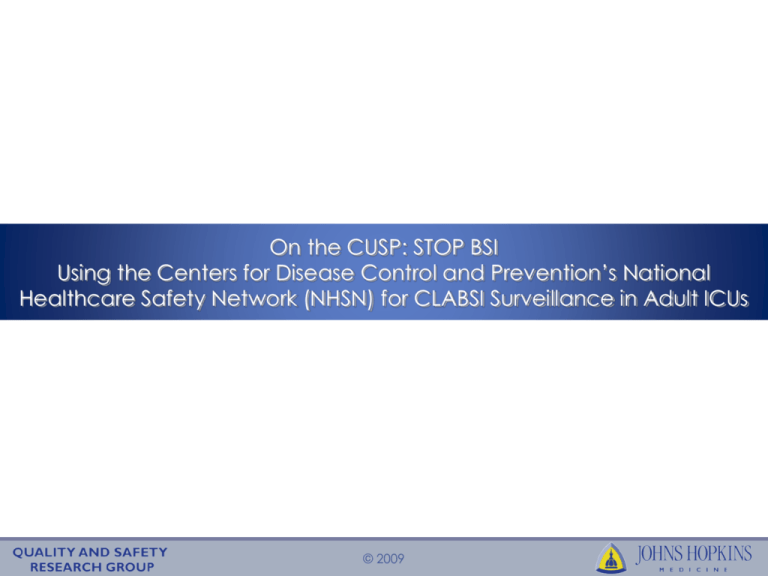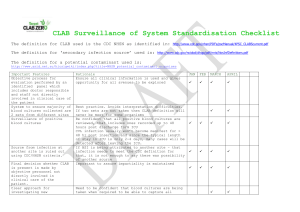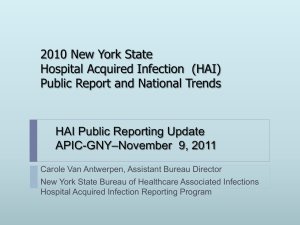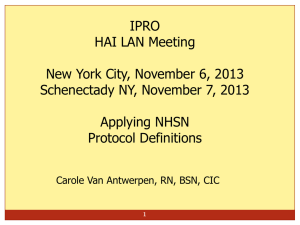Project Report - Lean Sigma
advertisement

On the CUSP: STOP BSI Using the Centers for Disease Control and Prevention’s National Healthcare Safety Network (NHSN) for CLABSI Surveillance in Adult ICUs © 2009 Learning Objectives • To review the NHSN definition of a central line • To review the NHSN definition of bloodstream infection (BSI) • To review the NHSN denominator definition for calculating CLABSI rates in adult ICUs © 2009 What is a Central Line? • An intravascular catheter that terminates at or close to the heart or in one of the great vessels which is used for infusion, withdrawal of blood, or hemodynamic monitoring. – Great vessel: aorta, pulmonary artery, superior vena cava, inferior vena cava, brachiocephalic veins, internal jugular veins, subclavian veins, external iliac veins, and common femoral veins – Infusion: introduction of a solution through a blood vessel via a catheter lumen • The location of the insertion site and type of device are NOT relevant © 2009 What is a Central Line? The following are examples of central lines, as long as they terminate at or close to the heart or in one of the great vessels NOTE: This list is not inclusive The following are examples of devices that are not central lines NOTE: This list is not inclusive Non-tunneled central lines Tunneled central lines Introducers Implanted ports Hemodialysis catheters Peripherally inserted central catheters (PICCs) • Femoral artery catheter • Pacemakers • Implanted cardiac defibrillators • Radial, dorsalis pedis, brachialis, ulnar arterial lines • • • • • • © 2009 Data That Need to Be Collected • For determining CLABSI rate – Numerator: number of CLABSIs – Denominator: number of central line-days – Expressed as a rate of X CLABSI/1,000 central line days • #CLABSI/# central line days X 1000 • For determining the Central Line Utilization Ratio – Numerator: number of central line-days – Denominator: number of patient-days © 2009 The Numerator © 2009 Definition of BSI in Adults Criterion 1: • Patient has a recognized pathogen cultured from one or more blood cultures AND • Organism cultured from blood is not related to an infection at another site. © 2009 Definition of BSI in Adults Criterion 2: • Patient has at least one of the following signs or symptoms: fever (>38oC), chills, or hypotension AND • Signs and symptoms and positive laboratory results not related to an infection at another site AND • Common skin contaminant is cultured from two or more blood cultures drawn on separate occasions. – Blood from ≥ 2 blood draws collected within 2 days © 2009 Microbiology Examples of Common Recognized Pathogens (not inclusive) • • • • • • • • • • Examples of Common Skin Contaminants (not inclusive) • Diphtheroids: Corynebacterium spp. • Bacillus spp. S. aureus Enterococcus spp. E. coli Pseudomonas spp. Klebsiella spp. Enterobacter spp. Citrobacter spp. Serratia marcescens Acinetobacter spp. Candida spp. – Not B. anthracis • Propionibacterium spp. • Coagulase-negative staphylococci – Including S. epidermidis • Viridans group streptococci • Aerococcus spp. • Micrococcus spp. © 2009 When Are Organisms the Same? • If isolates are identified to the species level in one culture, and with only a descriptive name (i.e., to the genus level) from the other culture • If isolates are speciated but no antibiograms are done or done for only one of the isolates © 2009 When Are Organisms Not the Same? • If isolates have different antibiograms for two or more antimicrobial agents – For the purpose of NHSN antibiogram reporting, the category interpretation of intermediate (I) should NOT be used to distinguish whether two organisms are different © 2009 Timing of CLABSI • Central line-associated BSI – A central line was in place at the time of onset of the event OR – A central line was in place within 48 hours before onset of the event • There is no minimum period of time that the central line must be in place in order for the BSI to be considered central line-associated © 2009 Location of Attribution • The patient care area where the event became evident – CLABSIs in patients with central lines placed in noninpatient areas (emergency department, operating room) are attributed to the inpatient unit – Transfer Rule: If a CLABSI develops within 48 hours of transfer from one inpatient location to another in the same facility, the infection is attributed to the transferring location © 2009 Entering Numerator Data • The Primary Bloodstream Infection (BSI) Form (CDC 57.108) is used to collect and report each CLABSI that is identified during the month • Other data requested – – – – Specific criteria met for identifying the primary BSI Whether the patient died Causative organisms Organisms’ antimicrobial susceptibilities. © 2009 The Denominator © 2009 Collecting Central Line Days • For ICUs, the number of patients with one or more central lines of any type is collected daily, at the same time each day, and then summed – The total is reported for the month on the Denominators for Intensive Care Unit (ICU)/Other Locations (Not NICU or Specialty Care Area (SCA)) (CDC 57.118). © 2009 Collecting Central Line Days: Multiple Lines in an ICU Patient • If a patient has more than one central line (permanent or temporary) on a given day, count the day as only one central line day. © 2009 Action Items • Verify that the infection control group in your institution is collecting CLABSI rates based on the NHSN definitions for what is a central line and what is a BSI • Verify that both catheters days and patient days are being collected correctly in the ICU(s) © 2009 References • National Healthcare Safety Network (NHSN): Device-Associated (DA) Module – www.cdc.gov/nhsn/psc_da.html © 2009








